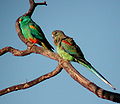
Mulga Parrot
Encyclopedia
The Mulga Parrot also known as the Many-coloured Parrot, is endemic in arid scrublands and lightly timbered grasslands in the interior of southern Australia.
in 1910, after its name Psephotus multicolor was ruled invalid as the original combination (Psittacus multicolor) had been used for another species. It is one of five species in the Psephotus
.
Common names include the Mulga Parrot, Many-coloured Parrot, and Varied Parrot.
 The male Mulga Parrot is multicolored from which the common name Many-coloured Parrot of this species is derived. It is a bright green overall, with a bluish tinge on the neck and above the eye, and paler on the breast. The rump is light green. The forehead is yellow and there is a red patch on the back of the head. The lower belly and thighs are yellowish marked with orange-red and the wings greenish apart from the yellow median wing coverts and blue outer webs of primaries. The long tail is an assortment of colours: the two long central feathers are dark blue tinged with green, the outer feathers are blue shading to white and there is some red on the upper tail coverts. Its bill is a blue-grey edged with black, and iris is brown. The female is duller overall, with an olive-brown head and chest, duller yellow forehead and red patch on the back of the head, and pale green belly, and more brown-grey bill. It has a red shoulder.
The male Mulga Parrot is multicolored from which the common name Many-coloured Parrot of this species is derived. It is a bright green overall, with a bluish tinge on the neck and above the eye, and paler on the breast. The rump is light green. The forehead is yellow and there is a red patch on the back of the head. The lower belly and thighs are yellowish marked with orange-red and the wings greenish apart from the yellow median wing coverts and blue outer webs of primaries. The long tail is an assortment of colours: the two long central feathers are dark blue tinged with green, the outer feathers are blue shading to white and there is some red on the upper tail coverts. Its bill is a blue-grey edged with black, and iris is brown. The female is duller overall, with an olive-brown head and chest, duller yellow forehead and red patch on the back of the head, and pale green belly, and more brown-grey bill. It has a red shoulder.
Taxonomy
The Mulga Parrot was given its current scientific name of Psephotus varius by American zoologist Austin Hobart ClarkAustin Hobart Clark
Austin Hobart Clark was an American zoologist. He was born in Wellesley, Massachusetts and died in Washington, D.C...
in 1910, after its name Psephotus multicolor was ruled invalid as the original combination (Psittacus multicolor) had been used for another species. It is one of five species in the Psephotus
Psephotus
The genus Psephotus has five species of parakeets from Australia. All species show considerable sexual dimorphism.-Systematics:Subgenus Psephotus:* Red-rumped Parrot, Psephotus haematonotus* Mulga Parrot, Psephotus varius...
.
Common names include the Mulga Parrot, Many-coloured Parrot, and Varied Parrot.
Description


